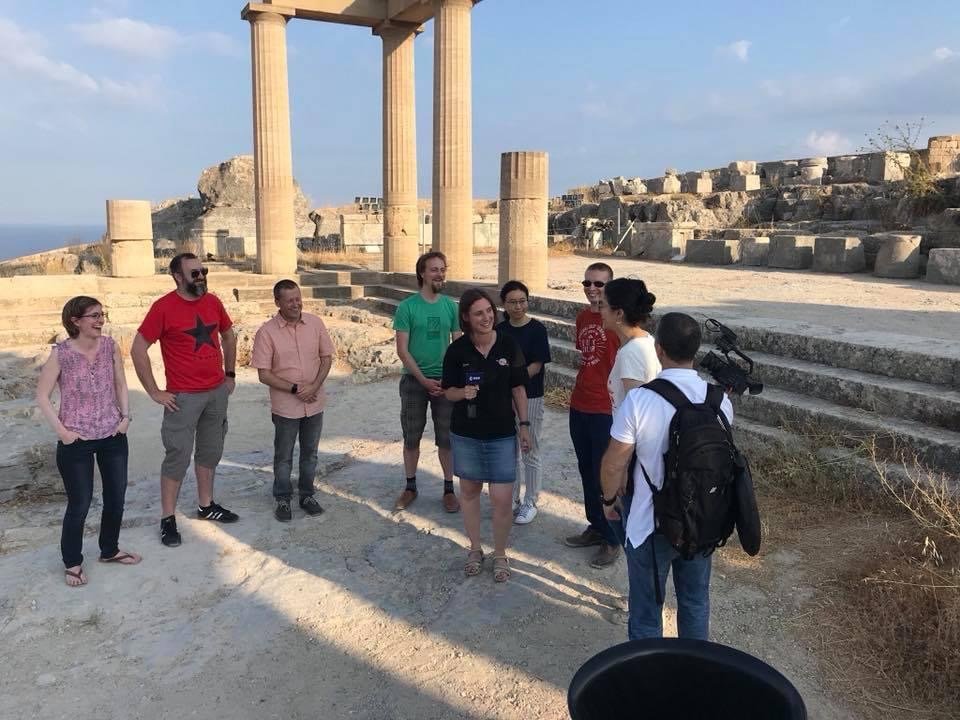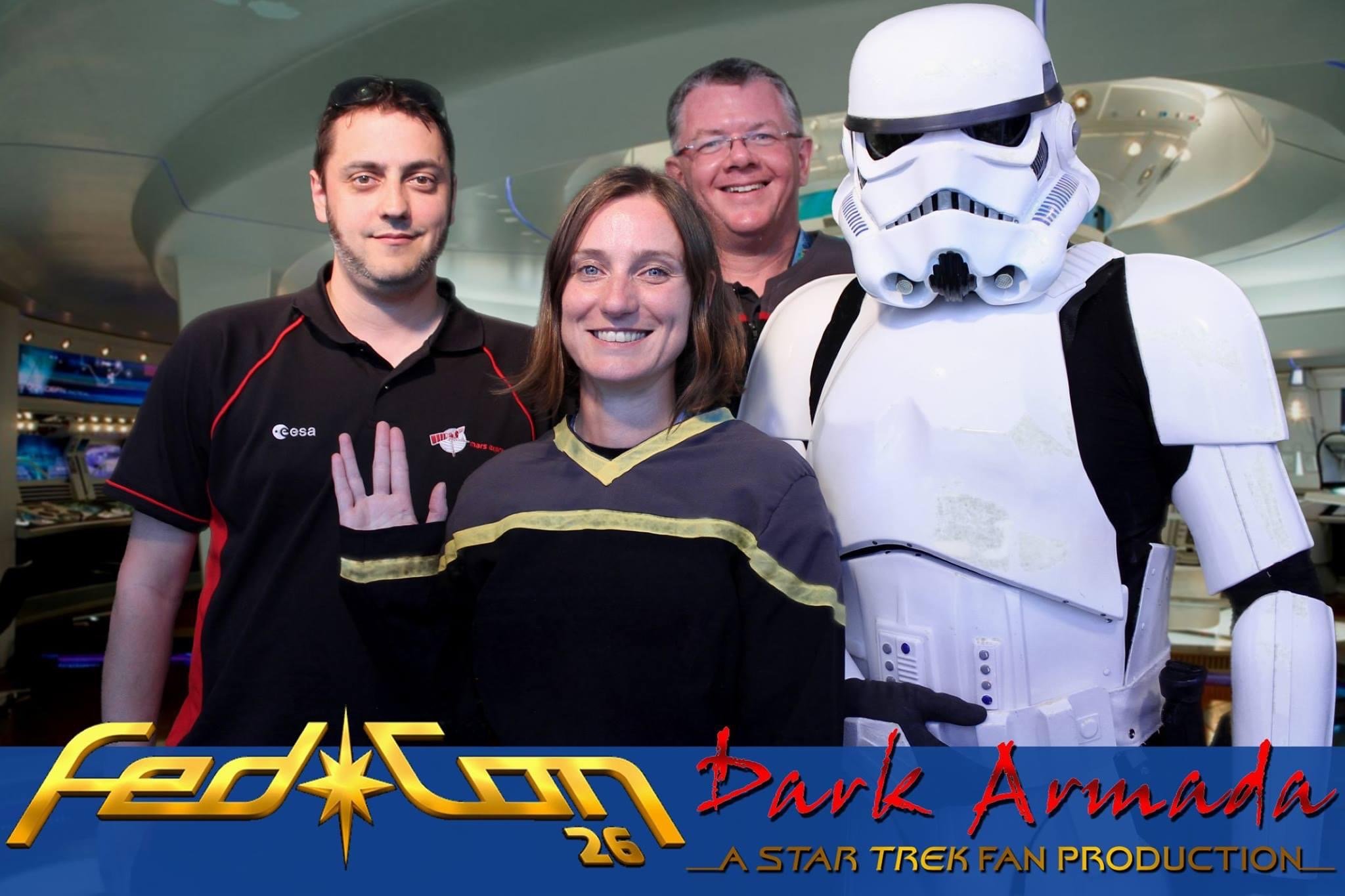
Dr Emily Baldwin
Senior Science Communicator – EJR-Quartz for the European Space Agency
Master of Science (planetary science), Doctorate of Philosophy (planetary science)
December 2021
Emily at her office desk. Credit: C. Carreau
Dr Emily Baldwin is Senior Science Communicator at EJR-Quartz. She uses her background in planetary science - a fun combination of geology and astrophysics - to tell the stories of the European Space Agency’s space science satellites that are exploring the Solar System and studying the wider Universe.
What do you do?
I work for a company called EJR-Quartz as their Senior Science Editor, and am based full time at the European Space Agency’s (ESA’s) ESTEC facility in the Netherlands – the Agency’s technical heart where we test a lot of our missions prior to launch.
Together with a small team, I write, edit, publish, coordinate and promote news about a fleet of about 35 missions past, present and future. On a working level this means writing a press release or science discovery news release, storyboarding a one-minute video script, providing inputs for an infographic, or preparing social media posts for @esascience or our mission-specific accounts.
I also work on big communications campaigns, contributing to the strategy planning side of things as well as generating content. Perhaps most well-known is the Rosetta mission where I played the role of the first person narrated @ESA_Rosetta Twitter account, co-produced storyboards for the cartoon spacecraft adventures, co-managed the Rosetta blog, and supported coordination of our various social media campaigns. Right now I’m working on our next big robotic exploration mission ExoMars, which will see the ESA-led Rosalind Franklin rover launch to Mars in September 2022 – watch this space!
On location filming in Rhodos, with the Rosetta OSIRIS imaging team.
What are the best parts about your job?
What are the hardest parts?
I love the variety. In the course of a day I might be writing or reviewing content on a black hole story, providing inputs for a new infographic to our graphics designer on an exoplanet subject, receiving a new image from one of our Mars orbiters to prepare a caption for, coordinating the release of a new story with our external partners, or preparing strategy notes for an upcoming flyby or launch campaign. And in between, answering emails, scheduling social media posts.… and drinking a lot of coffee!
With such a variety of missions and tasks, I get to work with a lot of different people both across the communications team and also on the individual missions at the various stages of testing, launching, and operating the spacecraft as they fly to their destinations, long before they start returning science data. This also means the occasional business trip to join mission scientists at their working team meetings, which has taken me to some pretty spectacular locations: from Svalbard to see the transit of Venus in 2012, to the Greek island of Rhodos for one of last Rosetta mission team meetings. I’ve also represented ESA at sci-fi conventions, which has included dancing on stage in the presence of David Hasselhoff, and drinking beers with cast members of Battlestar Galactica. Being a science editor is a very enriching experience!
With so many missions on our plate it can be challenging to keep up with it all, especially when launch dates slip, or there’s an unexpected last-minute action (why is it spacecraft decide to do something unusual on a Friday afternoon or weekend?!), but that’s also part of the thrill of why I love this job: surprises are always guaranteed!
My all-time favourite “me at work” photo. We had just received the ‘wake-up’ signal from Rosetta after it spent two-and-a-half years in deep space hibernation. I was given a seat in mission control, and was sending the “Hello World” tweet from @ESA_Rosetta, which also woke up at that moment. (Credit: ESA–Jürgen Mai)
Why did you choose this career pathway?
It kind of chose me! I had always loved creative writing at school, but also had a lifelong fascination with all things space, and took the science-focused route for my studies. During my PhD it became apparent that I enjoyed – and was better at – the writing up of lab reports, papers and literature reviews more than doing the actual science itself! I had been encouraged by my PhD supervisor Dr Ian Crawford into outreach by writing for young astronomers as part of the UK’s Society for Popular Astronomy and – thanks also to some freelance opportunities along the way (in other words: sometimes writing for free in exchange for feedback to gain experience) – landed myself a staff position as website news editor for the UK’s Astronomy Now magazine right after handing in my PhD. I stayed there for around four years, and also became deputy magazine editor.
It turns out that I love the buzz of short, fast deadlines and juggling multiple subjects – the complete opposite of the long and focused research of a PhD. I was delighted to discover the existence of science outreach, which enabled me to keep in touch with the scientific community I had grown up with academically, while satisfying my thirst for a variety of subjects.
Running through the content schedule with colleagues before Philae’s landing on a comet. Credit: C. Carreau
What are the major challenges in your field?
How content is consumed has dramatically changed in the ~15 years or so I’ve been working in science communications – I remember life before Twitter and Facebook, even! – so keeping up with new platforms and social media trends is a full-time job in itself. In addition, anyone and everyone can create online content, so it’s essential for professional communicators to have not only attractive content but also consistently reliable content to stand out from the noise. While the space science topics I work on are certainly inspiring and satisfy the human thirst for knowledge in understanding the Universe around us, it’s also important to stay relevant with societal conversation. For example, when climate change, a natural disaster, or the Covid pandemic dominate the global discussion, knowing if, when and how to contribute to the dialogue in a meaningful way can make a difference between the perception of ‘jumping on the bandwagon’ or providing useful and trustworthy content.
Probably one of the more surreal business trips I’ve made, helping to organise ESA’s presence at “FedCon”.
How well did your degree prepare you for your career path?
I didn’t know I would pursue a career in science communication at the time of choosing my degree, but it has provided me with the broad grounding needed to jump into the subject matter of any of our ESA missions at a basic level. My academic training means I know how to read a scientific paper or research a story, I understand how the research process works, and I can converse easily with scientists to ask meaningful questions about their research.
Having a background in science was a prerequisite for my current position, so I would say it prepared me well! Some of the contacts I made from scientific collaborations and conferences I still call upon or interact with today. I also cross paths with science colleagues at the same conferences I go to now representing ESA science missions, as if I would have remained a full-time scientist, so in some aspects, some things didn’t change much at all!
What were your career worries and expectations when you were at uni?
By doing a PhD I certainly felt an expectation to continue in research, so when I switched track, I was often asked if doing a PhD was a waste of time. It wasn’t. So please don’t feel disheartened or under pressure if you are unsure of what direction you want to take, whatever stage of your career or career decision making progress you are in. I use my PhD transferable skills as well as content knowledge pretty much every day! I don’t have any formal communication qualifications (social media qualifications were unheard of two decades ago!), but one of the reasons I was hired for my current position as a science editor, is because I have a solid science foundation. The rest is learned on the job.
Project shout out!
My pet “side” project at ESA is our new Pinterest account! Launched this year, I’m one of two main content curators in the driving seat behind it. The creative, relaxed nature of Pinterest makes it a very different channel to the fast-paced news-driven channel of Twitter, but I’m loving it as a way to showcase our most beautiful images of space, and revisiting evergreen content such as useful space teaching resources, space activities at home, space-related quotes, and space-themed gift ideas. We recently ran a space-themed Halloween party contest around the upcoming launch of the James Webb Space Telescope, which was really rewarding to see the fun and thoughtful ways people engaged with our channel.
I look after the science communications for many of these missions, in particular the Solar System explorers. Credit: ESA.
Connect with Emily






